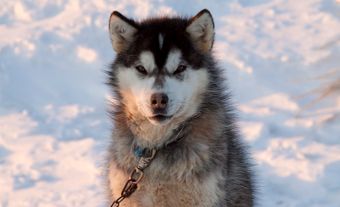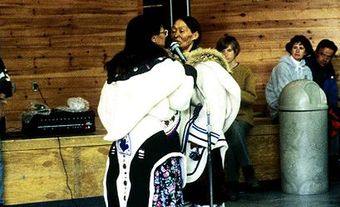Inuit — Inuktitut for “the people” — are an Indigenous people, the majority of whom inhabit the northern regions of Canada. An Inuit person is known as an Inuk. The Inuit homeland is known as Inuit Nunangat, which refers to the land, water and ice contained in the Arctic region.
Terminology
Inuit — Inuktitut for “the people” — are an Indigenous people, the majority of whom inhabit the northern regions of Canada. An Inuit person is known as an Inuk. (See also Arctic Indigenous Peoples in Canada.)
Take the quiz!
Test your knowledge of Indigenous peoples by taking this quiz, offered by the Citizenship Challenge! A program of Historica Canada, the Citizenship Challenge invites Canadians to test their national knowledge by taking a mock citizenship exam, as well as other themed quizzes.
Territory and Demography
The Inuit homeland is known as Inuit Nunangat, which refers to the land, water and ice contained in the Arctic region. The term Inuit Nunangat may also be used to refer to land occupied by the Inuit in Alaska and Greenland. By 2021, according to Statistics Canada, the Inuit population grew to 70,545, an increase of 8.5 per cent since 2016.
In 2021, approximately 69 per cent of all Inuit in Canada lived in Inuit Nunangat, with 44 per cent living in Nunavut, followed by Nunavik (in northern Québec), the western arctic (Northwest Territories and Yukon), known as Inuvialuit, and Nunatsiavut (located along the northern coast of Labrador).
Language and Ethnic Groups
There are eight main Inuit ethnic groups: the Labradormiut (Labrador), Nunavimmiut (Ungava), Baffin Island, Iglulingmuit (Iglulik), Kivallirmiut (Caribou), Netsilingmiut (Netsilik), Inuinnait (Copper) and Inuvialuit or Western Arctic Inuit (who replaced the Mackenzie Inuit).
Inuktitut, the Inuit language, has five main dialects in Canada: Inuvialuktun (Inuvialuit region in the Northwest Territories); Inuinnaqtun (western Nunavut); Inuktitut (eastern Nunavut dialect); Inuktitut (Nunavik dialect); and Nunatsiavumiuttut (Nunatsiavut). (See also Indigenous Languages in Canada.)
In 2016, 41,650 Inuit reported having conversational knowledge of an Inuit language or dialect. In Inuit Nunangat as a whole, 83.9 per cent of Inuit reported conversational ability in an Inuit language. Inuktitut usage was strongest in Nunavik, where the ability to converse in that language was 99.2 per cent. In Nunavut, 89.1 per cent reported the ability to converse in an Inuit language. In contrast, the figures for speaking an Inuit language (mainly Inuvialuktun and Inuinnaqtun) were 21.4 per cent in Nunatsiavut and 22 per cent in the Inuvialuit region.
Declining usage of Inuktitut prompted the Inuit Tapiriit Kanatami (ITK) — the national voice of Inuit in Inuit Nunangat, founded in 1971 — to establish Inuktitut curriculum in schools. Beginning in the 1960s, federal and territorial governments also worked to establish Inuktitut language programs, though for some, justification was partly based on the assumption that establishing such educational traditions would facilitate transition to English or French.
Culture and Life
Traditionally, the Inuit were hunters and gatherers who moved seasonally from one camp to another. Large regional groupings were loosely separated into smaller seasonal groups, winter camps (called "bands") of around 100 people and summer hunting groups of fewer than a dozen. Each band was roughly identified with a locale and named accordingly — the Arvirtuurmiut of Boothia Peninsula were called "baleen whale-eating people." (See also Igloo and Inuksuk.)
In contemporary northern communities, many types of food such as fruit, vegetables, and milk must be transported long distances, resulting in higher costs, limited availability and food that is not fresh. However, the availability of "country food"through harvesting and sharing partially explains the high percentage of Inuit who consume country food. A report released in 2005 found that a majority (68 per cent) of Inuk adults living in Inuit Nunangat harvested country food, which includes seal, whale, duck, caribou, fish and berries. Country food remains an important food source for many Inuit, with 65 per cent of households getting at least half their meat and fish from country food, and approximately 80 per cent of Inuit Nunangat families sharing country food with people in other households. (See also Food Insecurity in Canada.)
The Inuit have a rich and diverse culture. Inuit art, from carving to printmaking and more, demonstrates highly-skilled craftsmanship and artistry. Some well-known Inuit artists include Kenojuak Ashevak, Shuvinai Ashoona and Annie Pootoogook. Another popular cultural activity is Inuit vocal games, also known as throat singing. This is usually performed by two women producing a wide range of sounds from deep in the throat and chest. Many Inuit also compete in traditional games and sports such as high-kick (one and two foot varieties) and kneel-jump. Such games are featured in the Arctic Winter Games, held every two years.
History
During roughly 4,000 years of human history in the Arctic, the appearance of new people has brought continual cultural change. The ancestors of the present-day Inuit, who are culturally related to Inupiat (northern Alaska), Katladlit (Greenland) and Yuit (Siberia and western Alaska), arrived about 1050 CE.
As early as the 11th century the Norse exerted an undetermined influence on the Inuit. The subsequent arrival of explorers, whalers, traders, missionaries, scientists and others began irreversible cultural changes. The Inuit themselves participated actively in these developments as guides, traders and models of survival. (See also Eenoolooapik and Tookoolito.)
The effects of colonization have seriously impacted Inuit culture and life. Though largely ignored by the Canadian federal government until 1939, when a court decision ruled that they were a federal responsibility (though still not subject to the Indian Act) the Inuit were still subjected to policies that enforced assimilation into a “Canadian” way of life. Many Inuit children attended residential schools in Canada. (See also Inuit Experiences at Residential School.) Formerly nomadic peoples were transformed, sometimes through forced relocation ( see also Inuit High Arctic Relocations in Canada), into sedentary communities, and disc numbers were introduced to supersede an Inuit naming system that did not correspond to administrative needs. Disc numbers — so-called because they were distributed on small leather or pressed-fibre discs initially meant to be worn on one’s person — imposed a government sanctioned name on Inuit who may have been known by several names throughout their lives and depending on context. The system used location-based serial numbers. For example, filmmaker Zacharias Kunuk’s disc number is E51613. The imposition of disc numbers remains a culturally traumatic event, and has been criticized as fostering structural inequality. (See also Project Surname.)
Despite adjustments made by the Inuit over the past three centuries and the loss of some traditional features, Inuit culture persists — often with a greater reflective awareness. Inuit maintain a cultural identity through language, family and cultural laws, attitudes and behaviour, and through much acclaimed Inuit art.
Moving Toward Self-Government
In the late 1960s and early 1970s, Inuit began organizing politically in response to assimilative policies and government restrictions on traditional lands. In order to lobby effectively for land claims, Indigenous rights and self-government, a group of Inuit people formed Inuit Tapiriit Kanatami or ITK (then known as Inuit Tapirisat of Canada) in 1971. The organization supports and advocates for the interests of all Inuit living in 53 communities across Inuit Nunangat. Such interests represent an array of interconnected issues and challenges, including social, cultural, political, and environmental concerns.
First proposed by ITK in 1976, and supported by plebiscite in 1982, the Nunavut territory was agreed to in principle in a land claim in 1990, and formalized with the Nunavut Act in 1993. A strong base of politically experienced leaders allowed for a relatively smooth transition to official territory status in 1999. Three other land claim agreements in Inuit Nunangat support some level of Inuit self-government. The Makivik Corporation, through the James Bay and Northern Quebec Agreement, is working toward a self-governing Nunavik, as is the Inuvialuit Regional Corporation for Inuvialuit. Nunatsiavut has been self-governed since 1 December 2005 after the implementation of the Labrador Inuit Land Claims Agreement and the Labrador Inuit Constitution.
Did You Know?
On 27 January 2020, Inuit elder Qapik Attagutsiak was recognized by Parks Canada as a “Hometown Hero” for her “significant” contributions to Canada’s Second World War effort. Qapik was part of a nationwide effort to recycle bones, fats, metals and rubber for wartime production. Living on an island near Igloolik, west of Baffin Island ( Nunavut), Qapik collected walrus and seal bones which were used to make aircraft glue, fertilizer, and cordite (a type of explosive used in bullets). Qapik, 99, was honoured by Nunavut Commissioner Nellie Kusugak and Minister of Environment and Climate Change Jonathan Wilkinson at the Canadian Museum of History in Gatineau, Quebec.
Contemporary Challenges
Despite gains made in self-government and other fields like business, teaching, transportation, medicine and broadcasting (see also Inuit Broadcasting Corporation), many Inuit in northern communities face significant challenges, such as living in some of the most crowded conditions in Canada. Since being moved to permanent settlements in the 1950s and 1960s, Inuit have lacked adequate housing and have suffered related health problems. (See also Health of Indigenous Peoples in Canada.) In 2016, 51.7 Inuit in Inuit Nunangat reported living in over-crowded conditions, compared to 8.5 per cent of non-Indigenous peoples in Canada. Living conditions and lack of access to healthcare partially contribute to an increase in chronic health conditions, including obesity, diabetes and respiratory infections. (See also Social Conditions of Indigenous Peoples in Canada.) The suicide rate among Inuit youth is markedly higher than for the rest of Canada, making suicide prevention a key priority for continued cultural growth. (See also Suicide among Indigenous Peoples in Canada.)

 Share on Facebook
Share on Facebook Share on X
Share on X Share by Email
Share by Email Share on Google Classroom
Share on Google Classroom








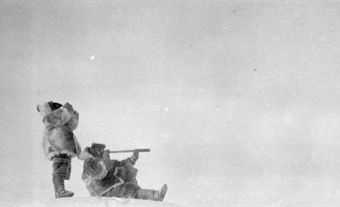




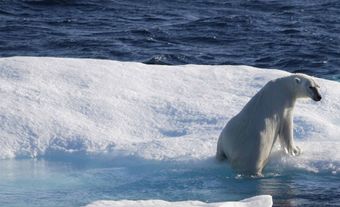


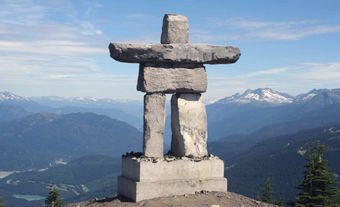
.jpg)
